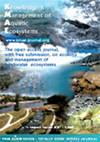基于高通量测序(high-throughput sequencing, HTS)的湖泊水体和沉积物中无脊椎动物卵的多样性比较
IF 1.7
3区 环境科学与生态学
Q3 FISHERIES
引用次数: 5
摘要
水生无脊椎动物多样性反映了水质和水生生态系统的健康状况,应作为淡水生态系统的基本特征加以监测。沉积物中水生无脊椎动物的卵在上面的水里繁殖。采用高通量测序(HTS)技术,利用一对18S rRNA基因连接引物,对雄安白洋淀沉积物中水域无脊椎动物及其静息卵的多样性进行了研究。从353,755个无脊椎动物(主要是浮游动物)序列中获得了99个操作分类单元(otu)。在水样中共分类出轮虫20种、桡足类11种、枝海类1种及其他18种,共50种。在沉积物中鉴定出37种,其中轮虫21种,桡足类3种,枝海类1种,其他12种。水体与相应沉积物共有24种。水样中无脊椎动物OTU丰富度高于沉积物(p < 0.01),而Shannon-Wiener指数差异不显著。这些结果表明,HTS是一种有效的生物多样性评估和监测方法。本文章由计算机程序翻译,如有差异,请以英文原文为准。
Comparison of invertebrate diversity in lake waters and their resting eggs in sediments, as revealed by high-throughput sequencing (HTS)
Aquatic invertebrate diversity reflects water quality and the health of aquatic ecosystems and should be monitored as an essential feature of freshwater ecosystems. The resting eggs of aquatic invertebrates in sediments populate the overlying water. The diversity of invertebrates in waters and their resting eggs in sediments in Baiyangdian Lake, Xiongan, North China, were assessed using high-throughput sequencing (HTS) with a pair of 18S rRNA gene adaptor-linked primers. The total of 99 operational taxonomic units (OTUs) derived from 353,755 invertebrate sequences (mostly zooplankton) were revealed by this study. A total of 50 species in the water samples including 20 rotifers, 11 copepods, 1 cladoceran and 18 other species were sorted out. In the sediment 37 species, including 21 rotifers, 3 copepods, 1 cladoceran and 12 other species, were identified. There were 24 species in common between water and corresponding sediments. Invertebrate OTU richness in water samples was higher than that in sediments (p < 0.01), while there was no significant difference in the Shannon-Wiener index. These results suggest that HTS is a promising alternative for efficient biodiversity assessment and monitoring.
求助全文
通过发布文献求助,成功后即可免费获取论文全文。
去求助
来源期刊

Knowledge and Management of Aquatic Ecosystems
环境科学-海洋与淡水生物学
CiteScore
3.70
自引率
5.60%
发文量
22
审稿时长
>12 weeks
期刊介绍:
Knowledge and Management of Aquatic Ecosystems (KMAE-Bulletin Français de la Pêche et de la Pisciculture since 1928) serves as a foundation for scientific advice across the broad spectrum of management and conservation issues related to freshwater ecosystems.
The journal publishes articles, short communications, reviews, comments and replies that contribute to a scientific understanding of freshwater ecosystems and the impact of human activities upon these systems. Its scope includes economic, social, and public administration studies, in so far as they are directly concerned with the management of freshwater ecosystems (e.g. European Water Framework Directive, USA Clean Water Act, Canadian Water Quality Guidelines, …) and prove of general interest to freshwater specialists. Papers on insular freshwater ecosystems and on transitional waters are welcome. KMAE is not a preferred journal for taxonomical, physiological, biological, toxicological studies, unless a clear link to ecological aspects can be established. Articles with a very descriptive content can be accepted if they are part of a broader ecological context.
 求助内容:
求助内容: 应助结果提醒方式:
应助结果提醒方式:


